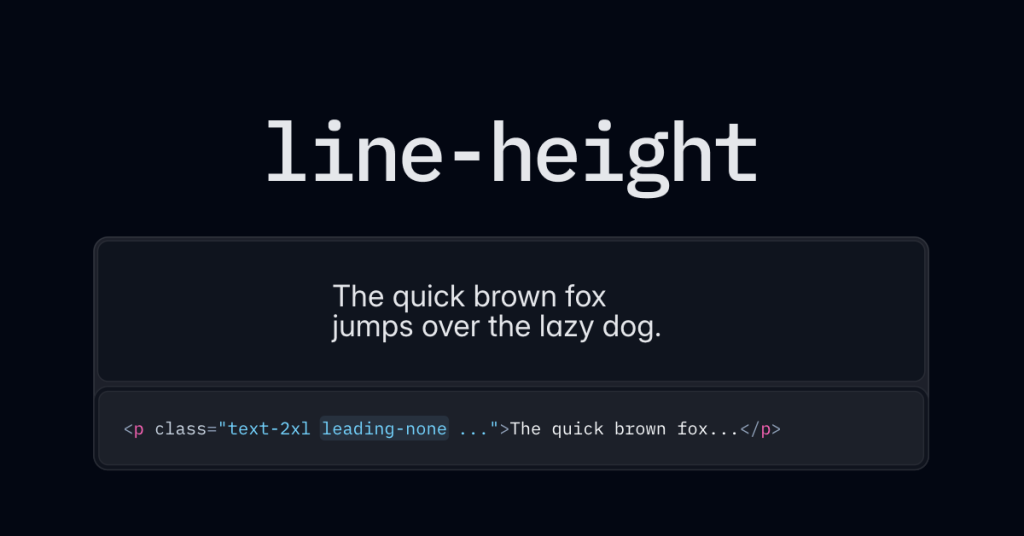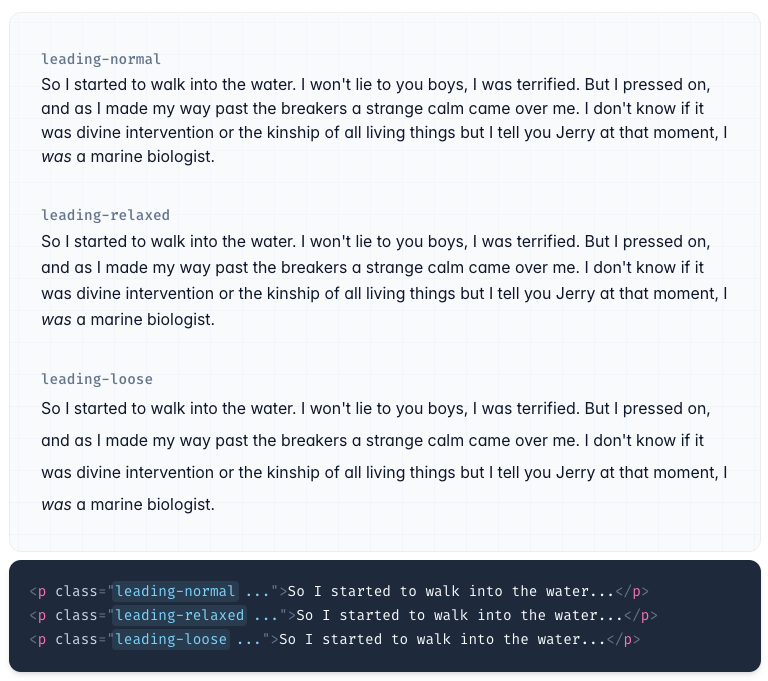Tailwind CSS Leading Font
Learn to control line‑height and enhance text styling with Tailwind CSS

Tailwind CSS offers an innovative utility‑first approach to styling, and one of the keys to creating visually appealing, readable text is controlling the line height. In this post, we’ll take a deep dive into Tailwind’s leading (line‑height) utilities, explore how to fine‑tune your typography, and share tips to build balanced, responsive designs.
Typography is more than just choosing a font.
It’s about creating a visual rhythm that guides the reader’s eye, improves legibility, and makes your content feel harmonious.
. one of the simplest—but often overlooked—tools for achieving this is line height. Tailwind CSS makes it easy to control line height with its set of “leading” utility classes.
What Is Line Height and Why Does It Matter?

Line height is the vertical space between lines of text. It can be defined as a unitless multiplier or as an explicit length (like pixels or rems). A well‑chosen line height improves readability by preventing text from feeling cramped or too loose. In traditional CSS, setting the line height often means choosing between different values manually, but Tailwind CSS provides pre‑defined classes to handle this easily.
For example, Tailwind offers utilities such as:
leading-none– sets the line height equal to the font size (no extra spacing).leading-tight– gives a slightly compressed line height.leading-normal– uses the default, balanced line height.leading-relaxedandleading-loose– add more space for a more open feel.
These utilities let you experiment and quickly adjust your vertical rhythm without leaving your HTML or component code. With these in place, achieving that perfect balance becomes less of a guessing game and more of a fine‑tuning process.
The Leading Utilities in Tailwind CSS
Tailwind CSS provides a range of utility classes for controlling line height, all based on a design scale that ensures consistency across your project. The official documentation explains that the “leading” classes are designed to work seamlessly with your text utilities (see Tailwind CSS Line Height Docs and v3.tailwindcss.com
Default Classes and Their Effects
Here’s a quick reference for some of the most common leading utilities:
leading-none: Line height is set to 1 (no extra space).leading-tight: A compact option, ideal for headings or bold statements.leading-normal: A balanced option, suitable for paragraphs.leading-relaxed: Provides extra breathing room, making text easier to read on longer passages.leading-loose: A very generous line height for an airy, open layout.
When applied alongside text size utilities (such as text-base, text-lg, etc.), these classes help maintain a harmonious typographic scale across your design.
Setting Up Your Project for Optimal Typography
Configure your template paths in your tailwind.config.js file so that Tailwind can purge unused styles (especially important with the Just‑In‑Time engine introduced in v3).
Tailwind’s configuration is highly customizable. In your configuration file, you can define custom theme settings for typography, including new line‑height values. This makes it easy to align your design tokens with your project’s overall look and feel.
How to Use the Leading Utilities: Practical Examples
Let’s explore some common scenarios where you might want to adjust line height using Tailwind’s leading utilities.
Styling Paragraphs
For body text, readability is key. The leading-normal class is typically a great default option. For instance:
<p class="text-base leading-normal text-gray-800">
When it comes to crafting beautiful web pages, the right balance between font size and line height is essential.
</p>In this example, text-base sets a comfortable font size while leading-normal ensures that the spacing between lines is optimal for long-form content.
Creating Impactful Headings
Headings often need tighter spacing to create a strong visual impact. You might choose a combination like this:
<h1 class="text-4xl leading-tight font-bold text-gray-900">
Welcome to the World of Tailwind Typography
</h1>Here, leading-tight compresses the vertical space, which can help group related header text closer together and provide a bold, impactful look.
Responsive Typography
One of the strengths of Tailwind is its responsive design capabilities. You can easily change the line height at different breakpoints:
<p class="text-lg leading-relaxed md:leading-normal">
Responsive design isn’t just about adjusting font sizes. Fine-tuning the line height for different devices can greatly improve readability on both mobile and desktop screens.
</p>With the above code, the line height will be more relaxed on smaller screens (enhancing legibility) and then switch to a more standard value on medium devices and up, maintaining visual balance across various viewports.
Advanced Techniques with Arbitrary Values
Tailwind CSS v3 introduced support for arbitrary values, giving you even more control over your design. This feature lets you specify custom line heights that aren’t part of the default scale. For example:
<p class="text-base leading-[1.15]">
Custom line heights can be specified using square bracket notation, allowing you to match your design’s exact requirements.
</p>This technique is especially useful when you’re working with unique fonts or when the default values just don’t cut it for your particular design. You can mix and match arbitrary values with other utilities to fine‑tune your typography with pixel‑perfect precision.
Customizing Your Tailwind Theme for Typography
Tailwind CSS is highly customizable, and you can extend or override the default settings directly in your configuration file. For example, if you want to add a custom line height value that better suits your design, you can do so like this:
// tailwind.config.js
module.exports = {
theme: {
extend: {
lineHeight: {
'extra-tight': '1.1',
'extra-loose': '1.8',
},
},
},
plugins: [],
};With these custom values added, you can now use leading-extra-tight or leading-extra-loose in your HTML. This flexibility allows you to create a unique typographic hierarchy that aligns perfectly with your design vision.
Using Theme Variables for Consistency
Tailwind’s theme variables (defined using the @theme directive in your CSS) help ensure that your design tokens remain consistent throughout your project. For example, you can define a custom color or font scale that automatically generates utility classes for you. This approach not only speeds up your development process but also enforces consistency in your design language. For more details, check out the Theme Variables documentation
Differences Between Tailwind CSS v3 and v4
While the core concepts of controlling line height have remained consistent, there have been a few updates and improvements in Tailwind CSS v4 compared to v3. Here are some key differences:
Enhanced Arbitrary Value Support
Both v3 and v4 support arbitrary values, but v4 continues to refine and optimize how these values are parsed and applied. This means that using custom values like leading-[1.15] works more seamlessly and reliably in v4, reducing potential conflicts and performance issues.
Improved JIT Engine
Tailwind CSS v3 introduced the Just‑In‑Time engine, which dynamically generates CSS as you work. In v4, the JIT engine has been further optimized for speed and efficiency, ensuring that even complex responsive and arbitrary utility combinations are handled swiftly. This is especially beneficial when working with advanced typography settings that require fine‑tuning.
Expanded Default Scales
While the default line‑height scale in v3 was robust, v4 offers more granular control in some areas. You might notice slight differences in the default values for utilities such as leading-tight or leading-loose—even if these differences are subtle, they can have a noticeable impact on the overall aesthetic of your design.
Additional Utility Classes and Variants
Tailwind CSS v4 has expanded its range of utility classes and variants. Although the fundamental utilities for line height remain, v4 may offer additional options or improved variant support, allowing developers to target specific states (like hover or focus) with greater precision.
Despite these updates, the overall workflow remains largely the same. If you’re already familiar with Tailwind CSS v3, transitioning to v4 should be smooth and intuitive, with the added benefit of enhanced performance and flexibility.
Best Practices
Now that you understand how to apply Tailwind’s leading utilities, let’s talk about some best practices to ensure your typography looks great across all devices.
Balance Font Size and Line Height
The key to readable text is finding the right balance between font size and line height. A common mistake is setting a font size without adjusting the line height, which can lead to text that appears too cramped or too loose. As a rule of thumb:
For body text, a ratio of about 1.4 to 1.6 is typically ideal.
For headings, a tighter ratio can create a more cohesive look.
Experiment with different combinations using both the predefined utilities and arbitrary values to see what works best for your design.
Use Responsive Variants Thoughtfully
Responsive typography isn’t just about changing the font size; it’s about ensuring that your text remains legible and aesthetically pleasing on every device. Tailwind makes this easy with responsive variants:
On smaller screens, you might use a slightly larger line height to improve readability.
On larger screens, you can adjust the line height to maintain a compact, professional appearance.
For instance, consider using:
<p class="text-base leading-relaxed md:leading-normal">
Responsive adjustments help maintain visual harmony whether viewed on a mobile device or a large desktop screen.
</p>Customize When Necessary
While Tailwind’s default settings work for most projects, don’t be afraid to customize your theme if your design calls for something unique. Whether it’s a custom line‑height value or a new responsive breakpoint, tailoring the configuration to your needs can make a big difference in the final look and feel of your website.
Test Across Devices
Typography can look different on various devices and browsers. Always test your settings across multiple devices to ensure consistency. Use browser developer tools to simulate different screen sizes and verify that your responsive variants are applied correctly.
Responsive Typography: A Closer Look
Responsive design is one of Tailwind CSS’s standout features. When it comes to typography, being responsive means more than simply resizing text—it means adjusting the vertical rhythm to match the screen’s real estate.
Creating a Responsive Scale
Consider a scenario where you have a display heading that needs to change size and line height between mobile and desktop devices. With Tailwind, you can achieve this by combining responsive utilities:
<h1 class="text-[26px] leading-[1.15] md:text-[32px] md:leading-[1.15] font-bold">
Responsive Display Heading
</h1>In this example, the heading is 26 pixels on mobile devices and scales up to 32 pixels on medium screens and above, all while maintaining the same proportional line height.
Why Adjusting Line Height Is Crucial
As you adjust font sizes responsively, the corresponding line height must also adapt to preserve legibility. A static line height might work for one font size but become either too cramped or too loose when the font size changes. Tailwind’s ability to control both properties simultaneously ensures that your text always looks its best.
Troubleshooting and Common Issues
Even with a robust system like Tailwind, fine-tuning typography can be challenging. Here are some common issues and tips to resolve them:
Inconsistent Vertical Rhythm
If you notice that paragraphs or headings don’t align as expected, double‑check your line‑height ratios relative to your font sizes. Inconsistent use of utility classes across different breakpoints can lead to uneven spacing. It’s a good idea to establish a baseline (for example, using leading-normal consistently) and only override when necessary.
Arbitrary Value Formatting
When using arbitrary values, ensure you follow the correct syntax. For example, leading-[1.15] must be enclosed in square brackets without any extra spaces. Incorrect syntax may result in the class not being applied.
Overriding Defaults
Sometimes, you might want to override the default line‑height values provided by Tailwind. Remember that many text size utilities come with their own default line‑heights. To ensure your custom settings take effect, either use the arbitrary value syntax or extend your theme configuration to set new defaults.
Browser Differences
Although Tailwind’s utilities are designed to work consistently across modern browsers, subtle differences in font rendering may occur. Always test in multiple browsers to ensure your typography remains consistent.
Customizing Tailwind Config for Advanced Typography
For projects with unique design requirements, extending your Tailwind configuration can be a powerful solution. You can add new line‑height values, customize responsive breakpoints, or even create your own utility classes.
Extending the Default Line‑Height Scale
In your tailwind.config.js file, you can extend the default line‑height scale to include custom values:
module.exports = {
theme: {
extend: {
lineHeight: {
'extra-tight': '1.1',
'extra-loose': '1.8',
},
},
},
plugins: [],
};After extending the scale, you can apply these new utilities like so:
<p class="text-base leading-extra-tight">
This paragraph uses a custom extra-tight line height for a compact appearance.
</p>Combining Multiple Typography Settings
Sometimes you might need to control not just the line height but also other typographic properties like letter spacing and font weight. Tailwind allows you to compose multiple utilities on a single element, making it easy to create a unique typographic style without writing custom CSS. For example:
<h2 class="text-2xl leading-normal font-medium tracking-tight text-gray-800">
Combined Typography Settings
</h2>This approach lets you tweak each property individually while ensuring a cohesive design.
Real-World Examples & Use Cases
Let’s take a look at some real-world scenarios where controlling line height with Tailwind can elevate your design.
Blog Posts & Articles
For long-form content, ensuring that your text is legible is paramount. Using a combination of text-base and leading-relaxed for paragraphs can make your articles feel open and inviting:
<article class="prose max-w-3xl mx-auto">
<h1 class="text-4xl leading-tight font-bold">Understanding Tailwind Typography</h1>
<p class="text-base leading-relaxed">
In today’s fast-paced digital world, reading comfort is more important than ever. Tailwind’s leading utilities help you achieve that perfect balance between style and readability.
</p>
<!-- More content -->
</article>The above structure is ideal for blog posts, where the comfortable spacing can significantly enhance the reading experience.
Landing Pages and Marketing Sites
For landing pages where first impressions matter, tight and impactful headings combined with carefully spaced supporting text can make your message stand out. Consider using a tighter line height for headings and a more relaxed one for body text:
<section class="py-12 bg-gray-100">
<div class="container mx-auto text-center">
<h1 class="text-5xl leading-tight font-bold text-gray-900">
Welcome to Our Product
</h1>
<p class="mt-4 text-lg leading-relaxed text-gray-700">
Our innovative solution brings you a seamless experience across all devices.
</p>
</div>
</section>This combination emphasizes your key message while ensuring that supporting text is easy to read.
User Interfaces and Component Libraries
When building reusable components, such as card interfaces or navigation menus, consistent typography is crucial. You can define component‑level classes that use Tailwind’s leading utilities to maintain consistency across your UI:
<div class="p-6 bg-white shadow-md rounded-lg">
<h3 class="text-xl leading-snug font-semibold">Component Title</h3>
<p class="mt-2 text-base leading-normal text-gray-600">
This is a brief description of the component. The leading classes ensure consistent spacing.
</p>
</div>By using the same utilities throughout your components, you create a unified design language that’s easy to maintain.
Troubleshooting Common Issues
Even with a powerful tool like Tailwind CSS, you might run into some typographic challenges. Here are a few common issues and their solutions:
Issue: Text Appears Too Cramped or Too Spaced Out
Solution:Verify that your chosen line height is proportional to the font size. Experiment with both predefined classes (e.g.,
leading-normal,leading-relaxed) and arbitrary values until you find the perfect balance.
Issue: Inconsistent Spacing Across Breakpoints
Solution:Use responsive variants consistently. For instance, if you set a custom line height for mobile, make sure to override it at larger breakpoints if needed (e.g.,
md:leading-normal). Check your Tailwind configuration for any conflicting settings.
Issue: Custom Values Not Being Applied
Solution:When using arbitrary values, ensure you follow the correct syntax. Values should be wrapped in square brackets without extra spaces (e.g.,
leading-[1.15]). Also, confirm that your JIT mode is active (default in Tailwind CSS v3 and v4) so that arbitrary values are correctly processed.
Conclusion
Controlling line height is a fundamental aspect of creating beautiful, readable web typography, and Tailwind CSS makes it both simple and flexible. With its intuitive “leading” utility classes, the framework empowers you to adjust the vertical rhythm of your text with ease.
As you build your projects, remember to experiment with different combinations of font size and line height to achieve the perfect balance.
FAQ
What does “leading” mean in Tailwind CSS?
It’s just a shorthand term for line height—the vertical spacing between lines of text.
How can I adjust the leading (line height) in my project?
You can use Tailwind’s predefined classes like leading-tight, leading-normal, and leading-loose, or set custom values with the arbitrary value syntax.
Can I make line height responsive?
Yes, simply combine leading utilities with responsive prefixes (like md:leading-normal) to adjust spacing across different screen sizes.
What improvements have been made regarding leading utilities in Tailwind CSS v4 compared to v3?
v4 refines arbitrary value support, improves JIT performance, and offers slight adjustments to default scales, ensuring smoother and more flexible typography control.

Yucel is a digital product creator and content writer with a knack for full-stack development. He loves blending technical know-how with engaging storytelling to build practical, user-friendly solutions. When he's not coding or writing, you'll likely find him exploring new tech trends or getting inspired by nature.